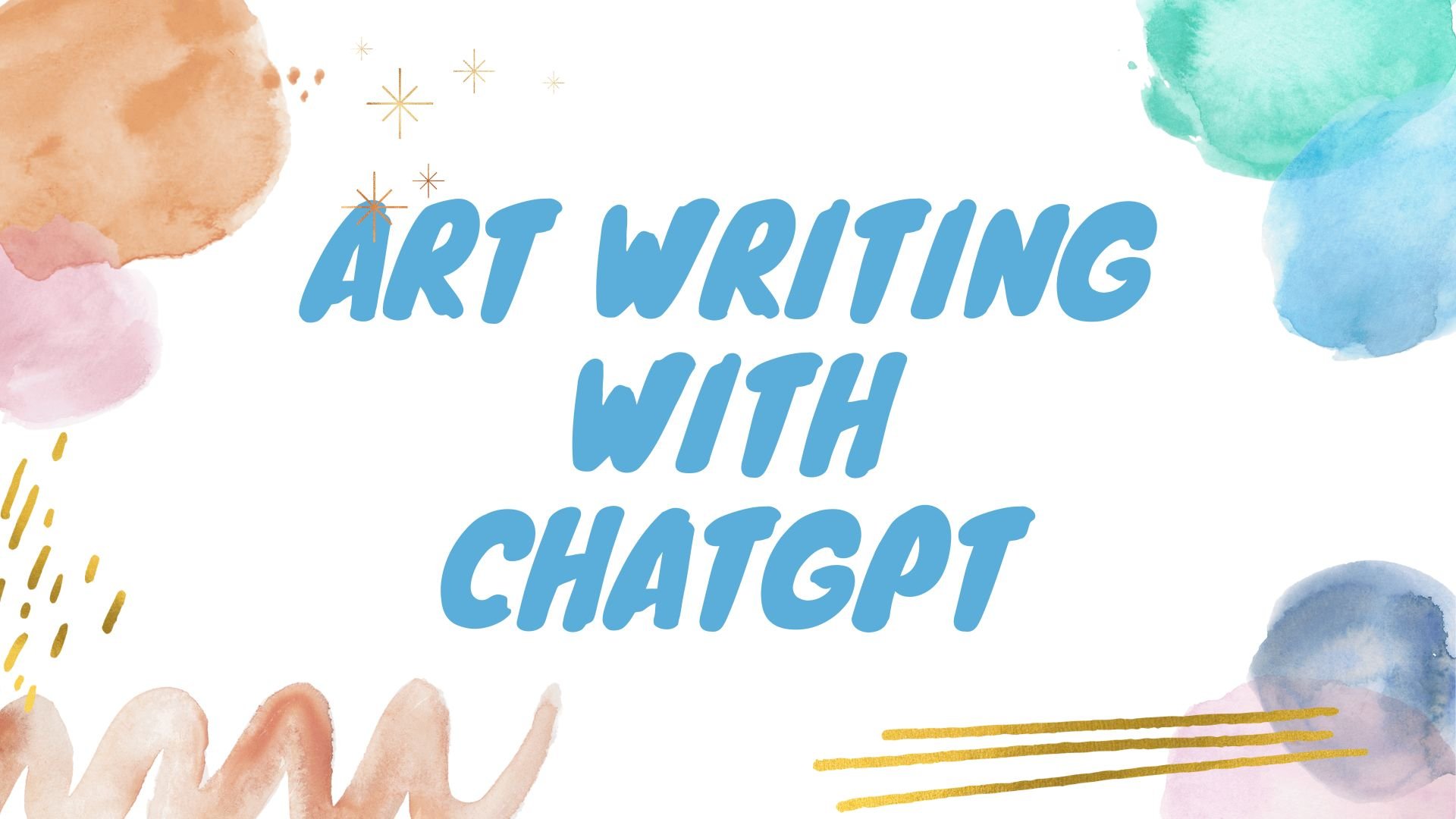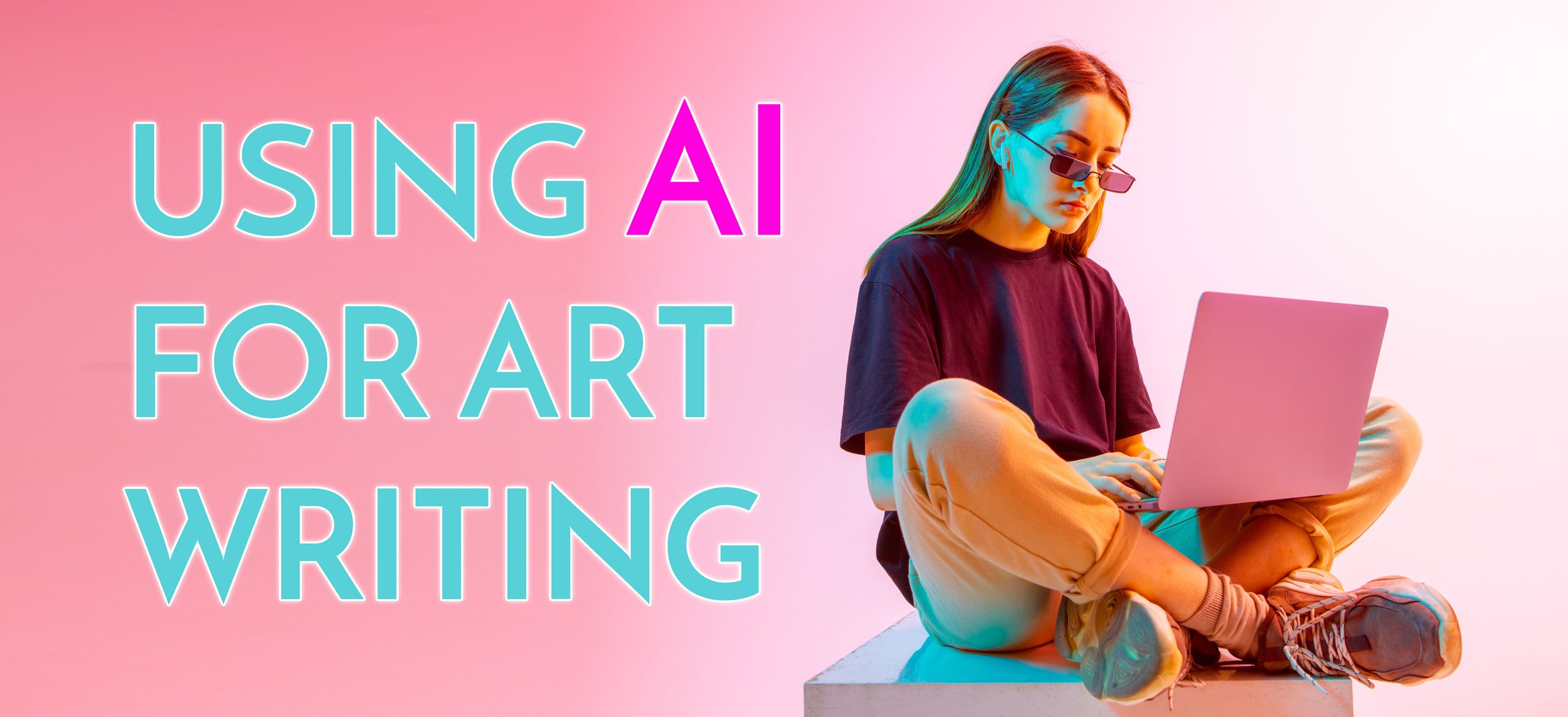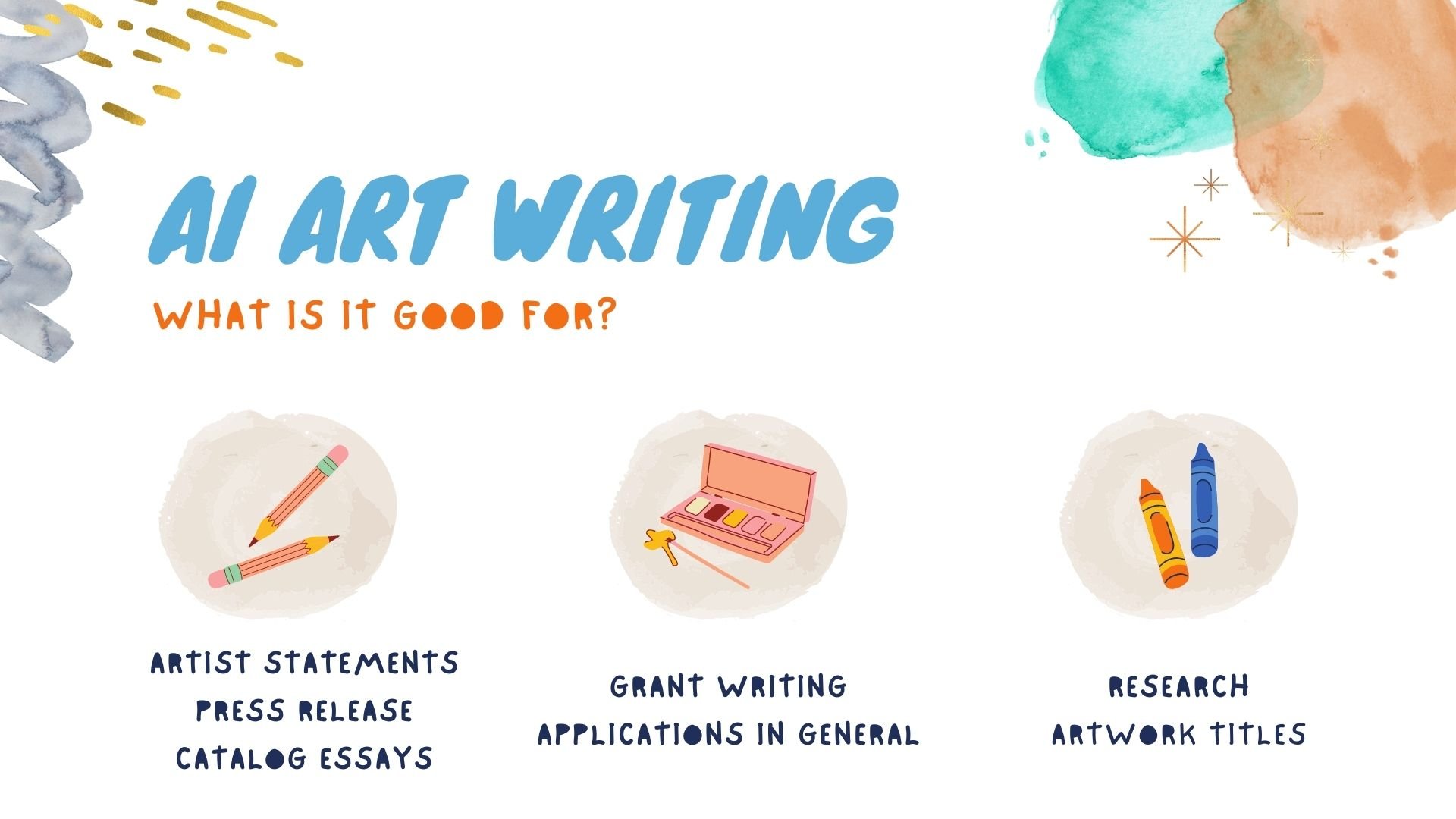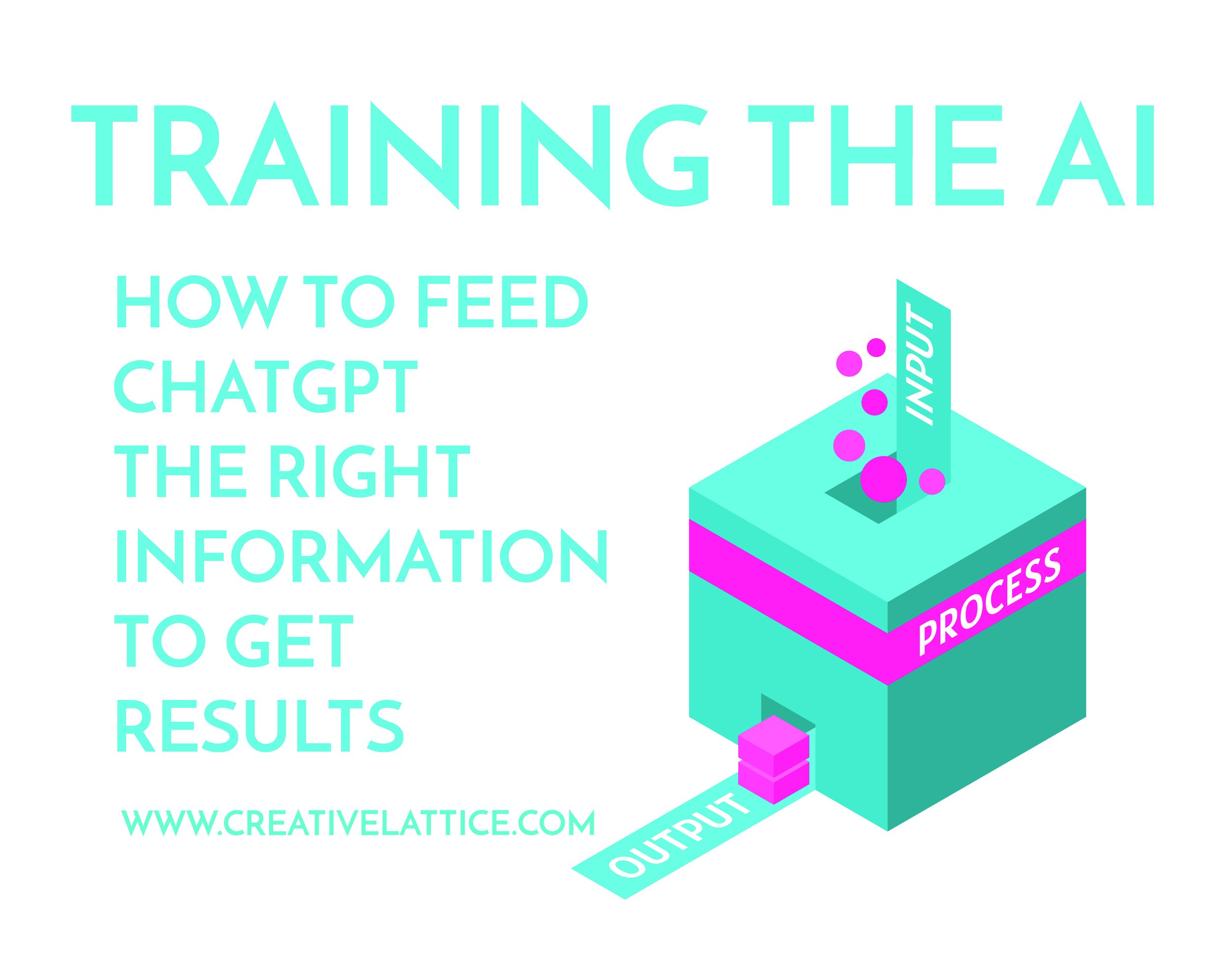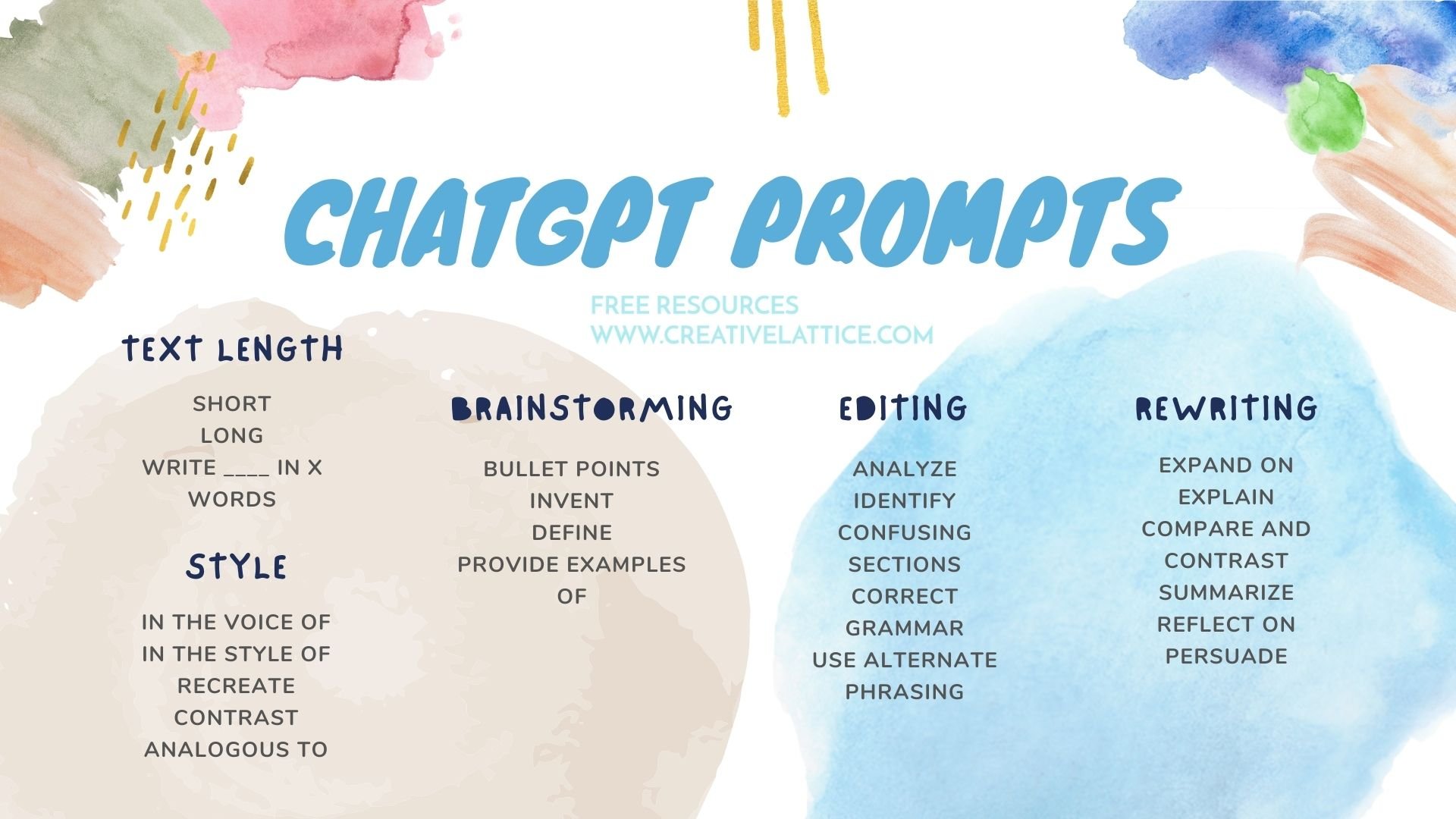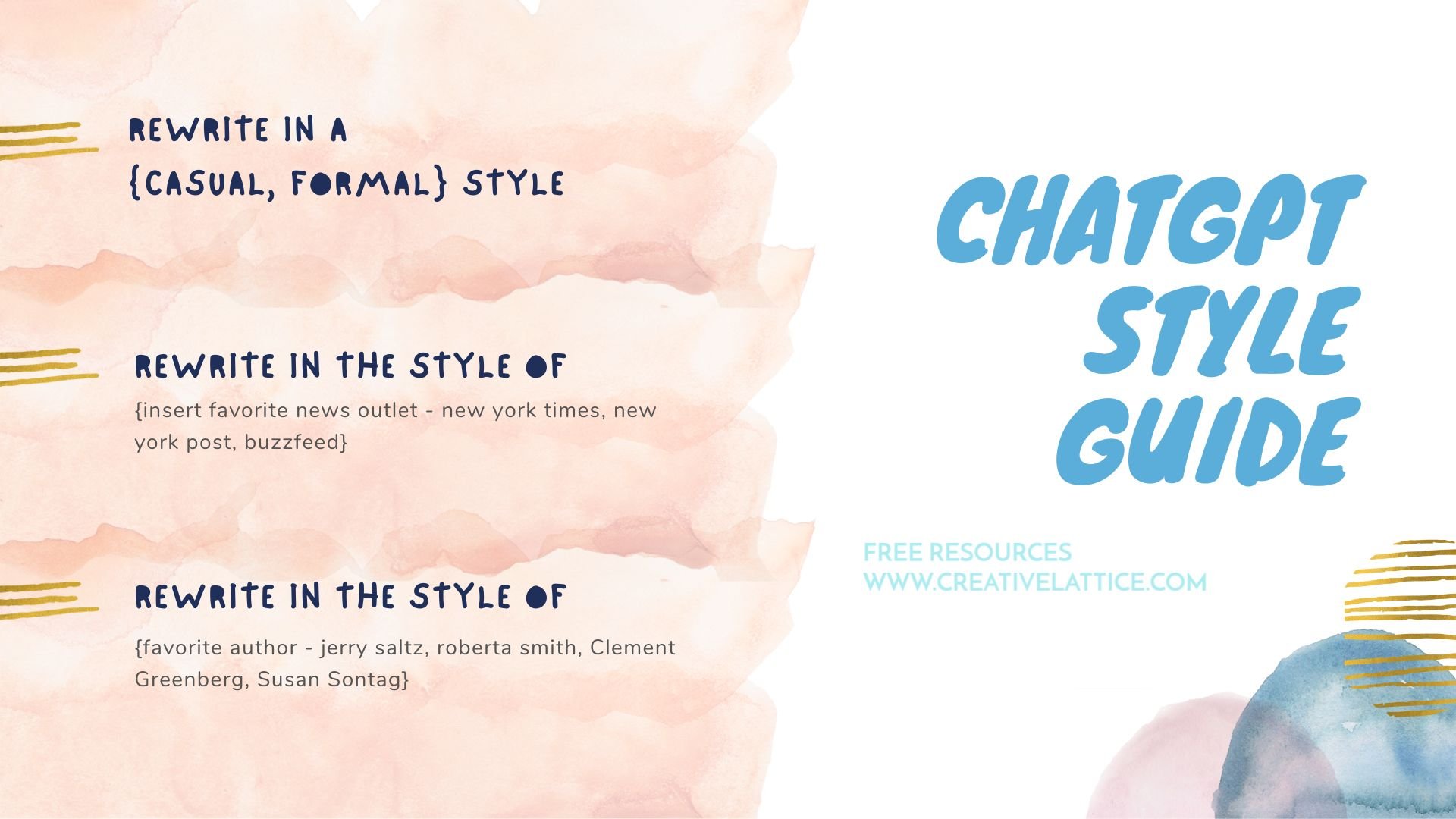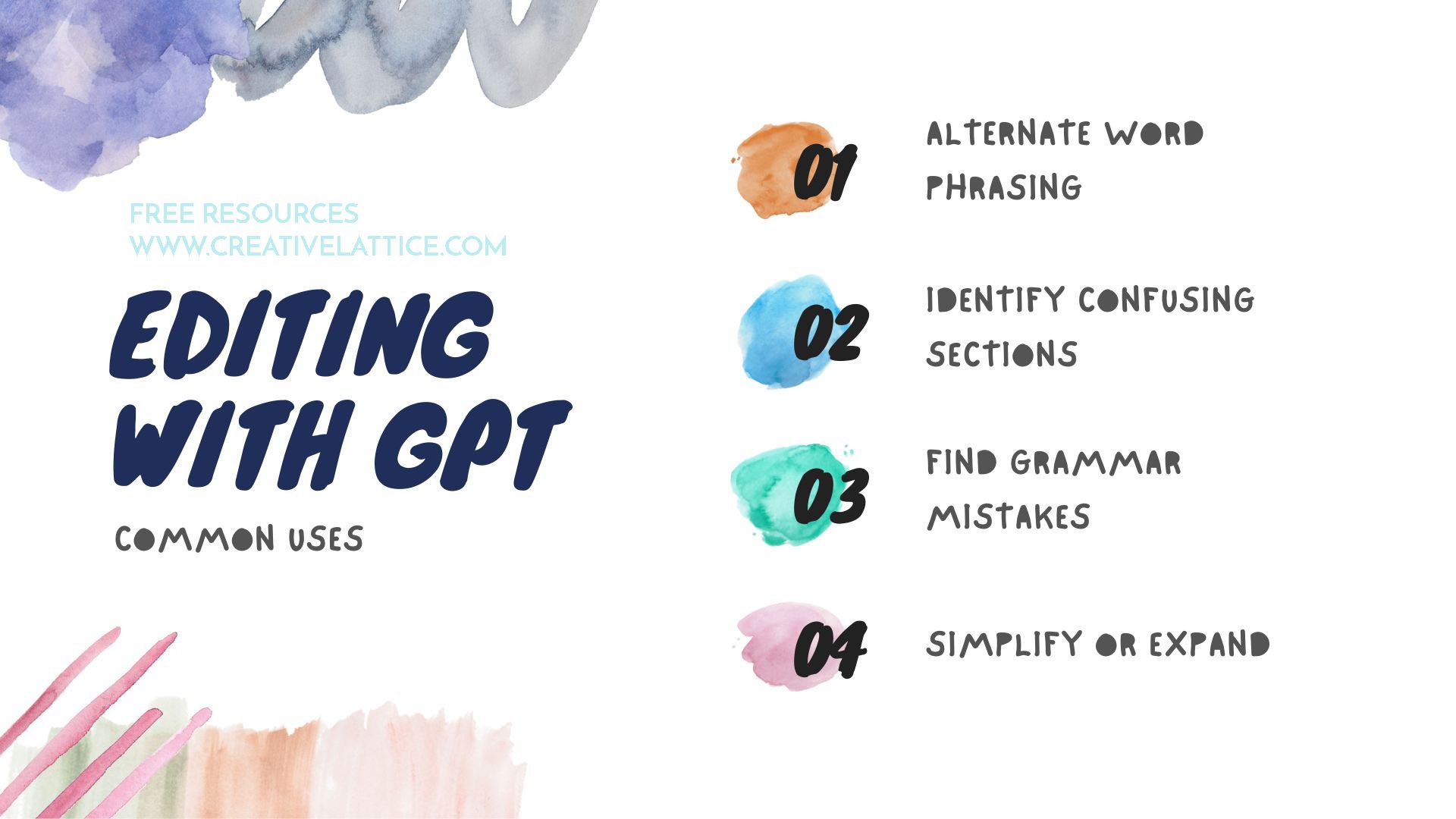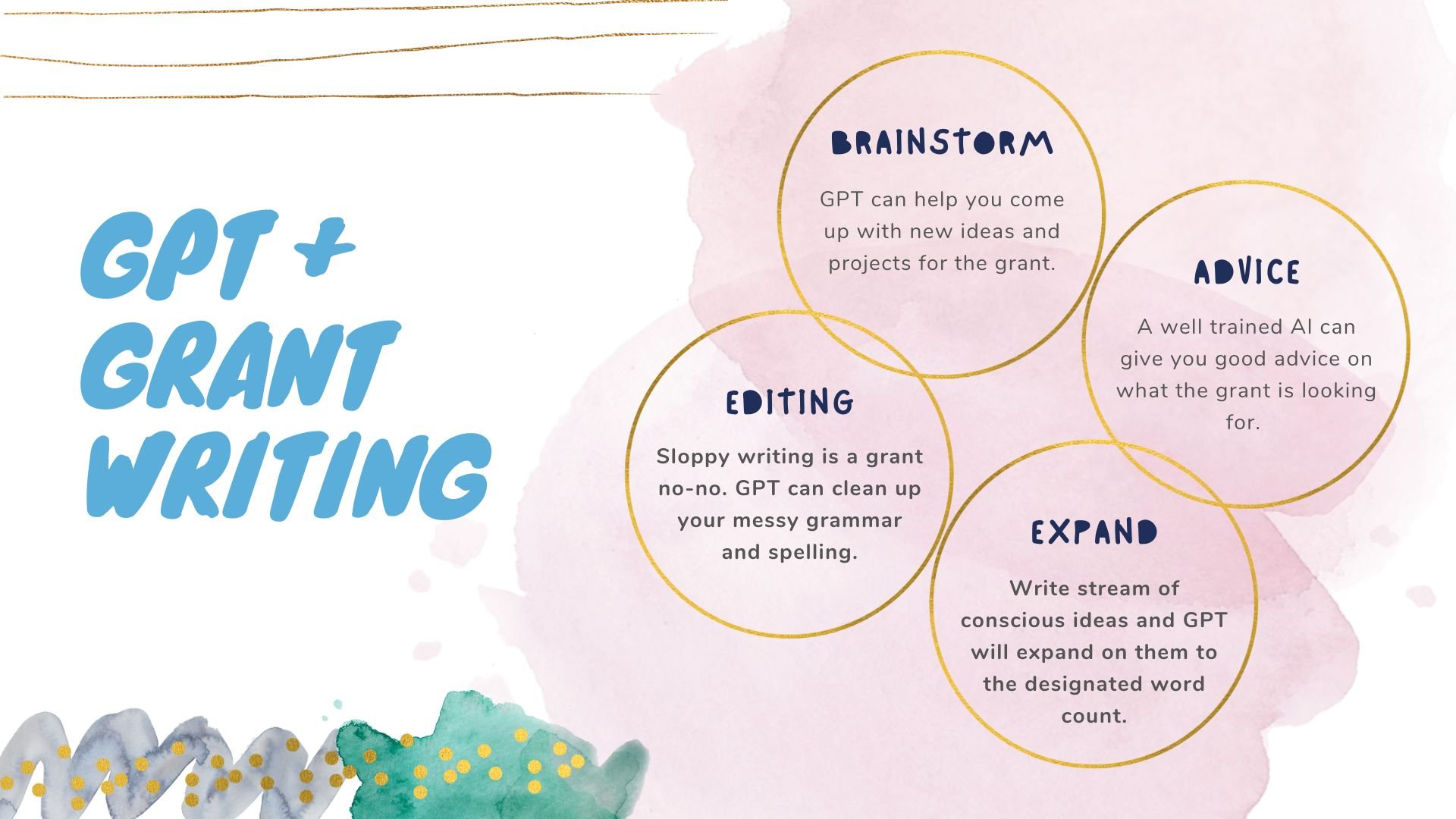Looking for an introduction to AI Art Writing?
Learn the basics in this helpful guide while diving deeper into the world of artificial intelligence writing for grants and artist statements.
In this article, I reviewChatGPT basics, how its helpful for artists creative business, and offer step-by-step tools for working with chatGPT. I even have an example of ChatGPT helping me write a grant!
TAKEAWAYS:
ChatGPT can provide quick written texts but it still needs a knowledgable expert to lead it.
ChatGPT’s database cutoff is 2020, so you will need to “Train” the AI for best results.
It’s all about using good prompts. From “expand” to “in the style of” to “identify the weak points”, you need to know the write prompts to get the best writing.
EIGHT WAYS TO USE AI IN YOUR ART WRITING PROCESS
HOW TO TRAIN CHATGPT
HOW TO WRITE BETTER PROMPTS FOR AI
PROMPTS FOR Length
PROMPTS FOR Brainstorming
PROMPTS FOR REWRITES
PROMPTS FOR Style
BEST WAY TO USE STYLE
How to use GPT for editing and refining your writing
Real-world use case: writing a grant application with GPT
WHAT IS CHAT GPT? AND WHY SHOULD ARTISTS CARE?
By now you’ve heard of ChatGPT.
It's basically a computer program that can read and analyze a ton of text and use that to come up with more text!
I used it to write this post!
It’s a game changer for artists. Tell GPT to "Write me an artist statement" and if it has some background info, it will spit out a passable statement! This makes GPT an awesome tool for artists for whom english is a second language or who are bad at writing.
ChatGPT is an equity game-changer. You no longer have to be wealthy to hire a grant writing assitant. Anyone can use GPT, they just need to be knowledgable about their subject matter.
ChatGPT can assist with first drafts or outlines getting you started on a project, which is super helpful. And when you're ready to polish things up, ChatGPT can proofread, suggesting better wording or spotting errors.
All in all, ChatGPT is a seriously powerful tool. It generates text from prompts, analyzes data, and helps fine-tune your work.
NOTE: If you log into GPT and get a busy message, there are a bunch of work arounds. ChatGPT seems to be always buys. So try: Simply waiting a little, Try on your mobile device, Refresh the page, Buy the service for $20 a month, Use a VPN, Use incognito mode, Avoid peak hours, Open a second OPenAI account, clear your browser cache.
ChatGPT is basically a super smart computer program. It learned by studying massive amounts of written stuff (data) from the internet, like books, web pages, and other things.
The data that ChatGPT uses depends on the version. The first GPT, was taught using a dataset called WebText, which had a good amount of text from web pages. The latest GPT-3 model was trained on an Common Crawl, which has over 45 terabytes of text!
GPT INFORMATION SOURCES AND HOW IT WORKS
You’ve probably heard that ChatGPT can be buggy.
I asked it to write me an artist bio and the result had a bunch of false information in it!
Also the bias of the data GPT was trained on can affect the language it generates. Like, if the training data is biased toward a certain group or way of thinking, ChatGPT might reflect that in what it says.
So, it's important to read what GPT writes, be skeptical, and use other sources for information gathering.
TAKE NOTE: ChatGPT’s data is NOT CURRENT. The original GPT model stopped learning new data in February 2019. The new GPT-3 model stopped in September 2020.
TYPES OF AI ART WRITING : HOW ARTISTS SHOULD USE GPT
ChatGPT can be used for writing in the arts in many ways.
Inspiration and idea generation: Users provide ChatGPT with a starting point and GPT brainstorms texts. This can help explore new perspectives and approaches to your work, overcome creative blocks, or provides starting points for your writing.
Research and information gathering: Users can input a question related to the arts, and ChatGPT can generate text providing relevant information or insights on that topic. This is my least favorite use of GPT since it’s so hard to tell fact from fiction.
Writing and Editing: Users can input a draft of their written work or even a few stream of conscious sentence. ChatGPT will expand, suggest edits, and provide alternative phrasing. This can be particularly useful for refining and polishing your press release before a big exhibition!
AI ART WRITING: WHAT IS IT GOOD FOR
Artist statements
Grant Proposals
Applications in general
Press Releases
Catalog Essays
Artwork Titles
General Research
EIGHT WAYS I USE AI FOR MY ART WRITING
Before we get into specifics, let me tell you the ways GPT makes art writing easy:
Request an outline/formula for a topic (press release, artist statement).
Ask for bullet points or summarize a new subject or a submitted text.
Brainstorm ideas on a specific topic (ask for 5 ideas for a grant proposal)
Ask it to rewrite a sentence differently (more exciting, toned down, using bigger words, using simpler words).
Rephrase or expand on a stream-of-consciousness sentence.
Request a response to a specific question or prompt.
Debate the pros and cons of a subject
Request a translation of a text into a different language.
HOW TO TRAIN CHATGPT
ChatGPT does not retain information from previous conversations unless the user provides some context or background information.
There are techniques that can be used to make ChatGPT more effective at retaining information.
A big help is when users provide additional texts at the beginning of each conversation. This helps ChatGPT get better information on a specific topic or subject matter.
Here are a few more strategies to train ChatGPT:
Start by introducing yourself and your purpose for the conversation. For example, say "Hi, my name is Jane, I’m a contemporary artist interested in learning more about the history of the Renaissance period.”
Provide specific details about the topic or subject matter that you want to discuss. Say "I'm interested in learning about the major artists and thinkers of the Renaissance period, esas well as the social and cultural context in which they worked."
Use relevant keywords or phrases that can help ChatGPT better understand the scope and focus of the conversation. For example, you might use terms like "painting," "sculpture," "philosophy," or "politics" to help guide the conversation in a particular direction.
Provide examples or specific questions that can help ChatGPT generate more accurate and relevant responses. For example, ask "Can you tell me more about the role of patronage in Renaissance art?" or "What were some of the major political and religious events that shaped the Renaissance period?"
HOW TO WRITE BETTER PROMPTS FOR AI
An AI prompt is a starting point provided to ChatGPT,
Prompts provide an important starting point for any text generated. Think of it like cooking. The spices you put in will make the dish taste different. Even the quality of the spices will make a different to the discerning taster!
Here are the best chatGPT prompts for art writing:
PROMPTS FOR LENGTH
Short: Used to write a short or concise piece of text.
Long: Writes a longer, detailed, or expanded text.
Write _____ in X word: Where X is the number of words you want to use. Such as “rewrite this artist statement in 100 words : (insert statement)”. Note: I’ve found it doesn’t always follow the word count exactly so always double-check the AI output.
PROMPTS FOR BRAINSTORMING
Bullet Point: gives you ideas in list form. Pull ideas out and ask it to expand on them.
Invent: Use this to prompt the AI model to invent or create something new, such as a proposal for a painting series about the environmental crisis.
Define: Provides a definition or explanation of a particular term or concept.
Provide examples: Gives examples or illustrations of a particular concept or idea.
PROMPTS FOR REWRITES
Expand on: The AI will write more text using your supplied text as a starting point.
Explain: Provides an explanation or description of a particular concept or idea.
Compare and contrast: Debates the positives and negatives of two or more ideas, concepts, or objects.
Summarize: Provides a summary or overview of a particular topic, idea, or submitted text.
Reflect on: Use this to prompt the AI model to provide reflections or insights on a particular topic, idea, or submitted text.
Persuade: Generates text that is persuasive or argumentative in nature, such as an essay or speech.
EDITING PROMPTS
Analyze: Provides a detailed analysis or examination of a particular idea or concept.
Identify confusing sections: Analyzes a provided text for weak points.
Correct grammar and spelling errors.
Use alternate phrasing : Rewrites a submitted text. I notice this is best done with shorter text segments like 1-2 paragraphs long. Otherwise GPT tends to lose information.
STYLE PROMPTS
In the voice of: Use this to prompt the AI model to write from the perspective or point of view of a particular character or persona.
In the style of: This is different from the prompt above in a very subtle way. "In the voice of" prompts may require more attention to character development and personality, while "in the style of" prompts may require more attention to genre conventions and literary techniques.
Recreate: In more creative writing this recreates a particular scene or setting, or captures the mood or atmosphere of a particular moment.
Contrast: Use this to prompt the AI model to highlight differences or contrasts between two or more ideas, concepts, or objects.
Analogous to: Writes text that is similar to or analogous to a particular idea or concept.
BEST WAYS TO USE STLE WITH GPT
This is one of my favorite prompts. It’s so helpful, here are three more examples on how to best use the In The Style Of prompt:
Rewrite in a {casual, formal, simple, complex} style
Rewrite In the style of {favorite news outlet - new york times, new york post, buzzfeed}
Rewrite in the style of {favorite author - jerry saltz, roberta smith, Clement Greenberg, Susan Sontag}
USING CHATGPT TO EDIT ART WRITING
Editing is the name of the game here.
Use ChatGPT to generate alternative phrasing or wording. If you're struggling to find the right words you can input a sentence or paragraph into ChatGPT and ask it to suggest alternative phrasing. This helps refine and clarify your message and avoids repetition or awkward phrasing.
Ask ChatGPT to identify unclear or confusing sections. Sometimes, it can be difficult to identify which sections of your artist statement is unclear or confusing. ChatGPT can help! It will provide feedback on which parts of your writing could benefit from additional clarification or detail.
Use ChatGPT for better grammar and spelling. ChatGPT can correct common grammar and spelling errors, making it a useful tool for proofreading and editing.
Use ChatGPT to help identify gaps or areas that need further development. ChatGPT provides insight into areas of your writing that needs further development or clarification.
Use ChatGPT to help you brainstorm new ideas or perspectives. ChatGPT helps generate new ideas or perspectives on your writing. This can be especially useful when you're stuck or feeling uninspired. Ask GPT for 5 ideas on a topic. Target the idea you like the most and ask it for 5 more ideas like that one!
WRITING A GRANT APPLICATION WITH CHATGPT
Wouldn’t it be nice if chatGpt could just write and submit a grant proposal for you?
Sadly, there is so much specific information required for grant proposals that artists still need to be hands on when writing. However, GPT can save you lots of time in the brainstorming, writing, and editing!
Here are four ways CHATGPT is helpful for grant writing:
Help you brainstorm: developing new ideas or perspectives for your grant proposal, such as asking it to suggest ways to approach the project or highlight your unique qualifications.
Expand on stream of conscious ideas: GPTS can quickly make a single sentence into a 100 word paragraph.
Use ChatGPT to refine and edit your sloppy grant writing, such as asking it to provide alternative phrasing or wording, identify unclear sections, correct grammar and spelling errors, and suggest areas that may need further development.
Advice: Training GPT by submitting the grant summary and the application, then the AI can bullet point what the grant is looking for and help stay on track!
USE CASE EXAMPLE: Creative Capital Grant
No better way to learn than by diving straight in!
In this example I use the recent Creative Capital Grant.
Ok! Let’s begin with training the AI.
The Grant: Go to the creative capital website and find a summary of the grant you are applying for. Then copy and paste that into a prompt: “Im applying for a creative capital grant. Here is what they say about it _________”
The AI will respond with information about how it thinks you should write the grant. Feel free to ignore it and come back to this later. At this point we’re still training the model.
The Artist: Now input your own information. “Let me tell you about myself, Im a ______. Here is my CV and BIO”
Again, it will tell you more about how you should approach the grant. Ignore it, we are still training.
Submit any recent reviews or press releases from recent shows. “Here is a recent review of my show: _______”
Ok! We got the ingredients set up, now it’s time to start cooking!
The first question on the Creative Capital Grant is writing a short description of your project in 25 words.
Ask the AI “give me five project descriptions for {Artist Name} to apply to a creative capital grant, make each about 25 words.
You will get back 5 ideas. Let’s say you kind of liked the 1st and 5th ideas. Your next prompt would be “give me 5 more ideas like number 1 and number 5”
There’s probably something in there you can start with.
Next question: Write a vivid 250 word project description. You could use a prompt like:
“In 250 words write a Project Description for {COPY PASTE YOUR FAVORITE SHORT DESCRIPTION} by artist {YOUR NAME}. The project description should give a vivid sense of the project. What will the work look like? What form will it take? How will the audience interact with the work?”
What ChatGPT gave me in response was a semi-usable description of my last show in 298 words. Okay, that’s a start!
Next I went back to the first recommendations the AI gave when I inputed the grant summary. It said “be innovative”. So I now ask:
“give me three ideas that would Emphasize this as innovative and risk taking”
And it actually generated some pretty good ideas!
Im not going to go through the whole process here because you get the idea of how to do this by now.
It’s important to understand that using AI to write doesn't mean you're wont do the work, it just makes the idea generation and writing easier.
You always need to copy and paste your text, ask for advice, brainstorm, copy and paste again, use stream of consciousness to generate more ideas, ask the AI to expand on your ideas, revise and edit your text, and repeat the process until you achieve the desired result.

